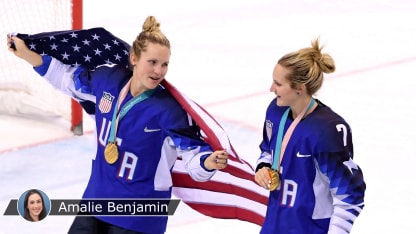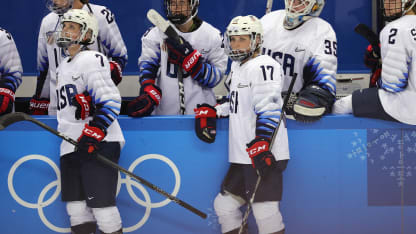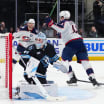The 2022 U.S. Hockey Hall of Fame induction is Nov. 30 in St. Paul, Minnesota. This year's class is made of up Steve Cash, Jim Johannson, Jocelyne Lamoureux-Davidson, Monique Lamoureux-Morando and Ryan Miller. Here, NHL.com staff writer Amalie Benjamin profiles Lamoureux-Davidson and Lamoureux-Morando.
Lamoureux twins make journey to U.S. Hockey Hall of Fame together
National team mainstays 'changed the face' of women's game, will be inducted Wednesday

Kendall Coyne Schofield kept correcting herself.
"I'm sorry," she said, yet again. "I'm going to 'they.'"
She had been asked, somehow, to separate two former teammates who were nearly inseparable, disentangling the careers of Jocelyne Lamoureux-Davidson and Monique Lamoureux-Morando, the twins who were longtime stalwarts of the United States national team, two of the best women's hockey players the country has seen.
She found it impossible.
"You know what I think of, is Serena Williams' final night at the U.S. Open when she lost," Coyne Schofield said. "She said, 'There's no Serena without Venus.' Like, there's no Monique without Jocelyne, there's no Jocelyne without Monique."
It's an apt comparison. Their games weren't the same -- one was a forward, one split time between forward and defenseman -- nor are their personalities. But the idea of one without the other is nearly unimaginable. Even for them.
"I would be surprised if you'd be able to [separate us], to be honest," Lamoureux-Davidson said. "It's just how it's always been, just growing up that way. I think at this stage in our lives, it would be weird if things weren't together at this point."
Which makes it fitting that the Lams, as they're known, will be inducted into the U.S. Hockey Hall of Fame together Wednesday at the Saint Paul RiverCentre, a celebration of not only what the two players have done individually, but what they've done alongside each other, including combining for the game-tying and shootout-winning goals to capture the gold medal at the 2018 PyeongChang Olympics, the first time the U.S. won gold in 20 years.
It's a celebration of the way the two changed the hockey that American women play on the ice, and the way they helped change the lives of female players off it. Together.
"It's always been a part of our dream," Lamoureux-Davidson said. "It was never I or me, it was always we, together. So I think it would be really difficult to picture going through this by myself or having her go through it by herself.
"It's just always been a part of what the dream has been for us, is to go through these steps together, play in the Olympics together. It was always the two of us. So I can't imagine it being any other way."
\\\\
There was little else they could do, not with four hockey-playing older brothers and a mother who kept her sanity and her marathon training intact with four-hour runs around the rink while her brood had their practices back to back to back to back, not with the frozen coulee out back in Grand Forks, North Dakota, that was good for hours and hours of entertainment, the girls readily jumping into games populated by older boys who expected they would simply keep up.
"I would call them forces of nature -- and that's almost immediately apparent," said Gordie Stafford, their coach at Shattuck-St. Mary's in Minnesota.
It was apparent when they headed to the school, setting out to turn a boys prep hockey powerhouse into an equally potent force for girls, setting off a run that would see Shattuck win 13 national championships between its prep and under-16 teams.
It was apparent when they left the University of Minnesota after their freshman season, heading to the University of North Dakota, hoping to turn an also-ran hockey school into a hockey hotbed.
It was apparent when they made the national team in 2006, going on to become mainstays for the next 14 years, playing in seven IIHF Women's World Championships (six gold medals, one silver) and three Olympics, winning silver in 2010 (Vancouver) and 2014 (Sochi), and gold in 2018.
"In my opinion, they changed the face of women's hockey, overall, just because of the way that they played the game," Stafford said. "I would never advocate for checking in girls hockey, but girls hockey, women's hockey is a physical sport. You're entitled to your ice, and I think the way that they played the game is the way that the game should be played."

© Dave Sandford/Getty Images
Both had played boys hockey until they enrolled at Shattuck, which impacted the way they played the game, the forcefulness, the physicality. Stafford would have to defend them to referees to ensure that they weren't penalized simply for being strong, encouraging them to play with intensity but not emotion.
But as much as he made sure that they played within the rules, he also saw the game -- and Hockey Canada -- bending to them. He wasn't the only one.
"I think when the Lams came along and both of them played that very similar style, with an edge, it raised everybody's feeling about creating that contact, pushing people back off that line and don't cross that line," former national team and current Harvard coach Katey Stone said. "I think that is a huge piece of that rivalry. We're going to play our best, we're going to bring out the best in each other, but don't mess with us. You need to have that type of intimidation factor."
\\\\
But as often as they get lumped together -- and understandably so -- their careers were "vastly different," as Lamoureux-Morando put it.
Lamoureux-Morando played defenseman on and off over her career, her preferred position, though she led teams in points and made all-star rosters from both forward and defenseman. She was a forward at all three Olympics in which she played, which has obscured the ways her playing career is remembered.
"I don't know if it gets talked about enough is Monique's ability … whether she was a forward or whether she was a [defenseman], she led the tournament in points, in plus-minus, in this and that, from the blue line or from a forward position," Coyne Schofield said. "It is hard enough to go from left wing to right wing, let alone going from forward to defense. And then to be that good at both of them is crazy."
She had an impressive power game, which belied a personality that has always been more introverted than that of the fierier Lamoureux-Davidson. As Stafford put it, "I think a lot of times Monique got roped into melees and scrums that Jocelyne started."
But it was Lamoureux-Morando's ability to be whatever the coaches wanted that was so valued and so valuable.
"Her willingness to go wherever needed to me was very selfless," Stone said. "When you coach elite athletes, they oftentimes get in their lane and they don't want to get out of it. They don't like feeling uncomfortable at times. And she embraced it. Whatever she needed to do, she was going to do it."
Lamoureux-Davidson, on the other hand, was the owner of an Alex Ovechkin-style one-timer, a "tough as nails" player, according to Stone, and one who also played with finesse. She had hands, vision, and a 200-foot game.
"Just pure determination," Lamoureux-Morando said. "In a funny way, I think of Happy Gilmore, when he's playing at the beginning [of the movie], like 'That's my puck and no one touches my puck.' That was her attitude. If someone thought they could beat her, she's like, 'OK, I'll show you.'"
That, though, was a shared trait.
"Their inner drive is immense. It's immense," Stone said. "They have something inside of them that, no matter what the situation, they were going to rise."
\\\\
Which is exactly what they did in 2018.
After the U.S. had won consecutive Olympic silver medals, U.S. women were facing Canada -- again -- in the gold medal game in PyeongChang.
With Canada up 2-1 in the third period, a save by goalie Maddie Rooney led to a breakaway by Lamoureux-Morando with 6:21 remaining between the Canadians and yet another gold. It was a goal that, like the one that would follow, was predicated on hours of practice and anticipation of a scenario that might never happen, as she caught the hard backhand pass, corralled it, and converted.
"People don't see the work that goes into that," Lamoureux-Morando said. "It's an underrated skill and it's not that fun to work on. But that's the stuff that at the end of the day, if you can't catch that pass, that blows up off your stick and it's in the corner and it's not a breakaway."

© Maddie Meyer/Getty Images
Instead, the game was tied, heading to overtime and then, finally, the shootout. And in came Lamoureux-Davidson, the sixth shooter for the U.S. She approached Shannon Szabados, deked to the Canada goalie's right and then back to her left, a filthy move that was as calculated as it was cold-blooded.
"Look at Jocelyne's 'Oops, I Did It Again' goal," Coyne Schofield said, referring to the name North Dakota associate coach Peter Elander gave the move, after the Britney Spears song. "Who has the guts to do that move in the gold medal game with the gold medal on the line? We haven't won in 20 years."
Only Lamoureux-Davidson.
But, really, it wasn't entirely guts. Like with Lamoureux-Morando's goal, it was a move she had practiced and honed, over and over and over, early mornings with Elander, perfecting the imperfectible. It was everything that they represented, the work ethic, the skill, the preparation, the nerves of steel. Thousands on thousands of reps on something they might never use.
"I saw the look in her eye and it was just like ice in her veins," Lamoureux-Morando said. "I'm like, she's going to score. I didn't know what she was going to do. But when she did it, I was like, she pulled it off perfectly.
"To know the work that goes into a moment like that, to have that moment, you couldn't cap off a career any better than that. It's just the epitome of our career, all the work that we put in to have a moment like that."
\\\\
As big as their legacy is on the ice, for the women on the national team, it might match what they helped bring about off it.
The two led the charge through a near-boycott of the 2017 world championships on their way to a new contract with USA Hockey that included fairer compensation, travel accommodations, and maternity benefits -- becoming the first two to take advantage of those benefits when they had boys six weeks apart in December 2018 (Lamoureux-Morando) and January 2019 (Lamoureux-Davidson).
"A lot of the support that we've received as players is thanks to the fight of Monique and Jocelyne starting back in 2016," Coyne Schofield said. "We are all benefitting."
When asked about what they're most proud of in their own careers, that's what both Lamoureux-Morando and Lamoureux-Davidson mention. Not the Olympic gold. Not the goals. Instead, it's the contract negotiations that have, and will continue to have, such a big impact on the lives of the women on the team, both improving their lives and strengthening the team itself, allowing the stars to devote more of their time and energy to training, allowing them to play longer.
"To stand up when you think things aren't the way they should be and to be a voice for people who have historically not had a voice," Lamoureux-Davidson said, of that why that fight mattered.
Lamoureux-Morando said, "That goes beyond medals and championships."
\\\\
Pierre-Paul Lamoureux was asked when he knew what might be possible for his sisters, the youngest of the six-kids-in-five-years Lamoureux brood, when he knew how they might rise from the organized chaos of their household.
"Day One," he said.
"We knew right away that they were gifted. And not just athletically."
There was a mindset that pervaded the Lamoureux household, an idea that they could all excel, that they could all play and accomplish big things, that the Olympics weren't an outlandish goal and that enormous aspirations were expected.
And they accomplished it all. They changed the lives and the careers of those around them, they came up big in the biggest moments, they outworked everyone and led by example and scored two of the biggest goals in U.S. women's hockey history.
They did all they could have imagined. All they did imagine.
"The legacy is huge," Coyne Schofield said. "When I think of two of the greatest teammates I've ever had, it's Monique and Jocelyne. It's because they taught me how to work. They taught me how to fight. They taught me how to stand up for what you believe in. They taught me how to be a great teammate, a great competitor. They did everything."
There were, of course, giants that came before them: Cammi Granato and Angela Ruggiero, Stone and Digit Murphy, those who had formed the game into what it had become by the time the Lamoureux twins showed up.
"But I think the foundation they set of the competitive nature of female athletes, from a hockey perspective," Stafford said, "I think they changed women's hockey and brought it to a level of grace and finesse and physicality and intensity that it is today.
"I think USA women's hockey from now forward is going to be compared to what it was like in the twins' era -- Hilary Knight, Kendall Coyne, Brianna Decker, Amanda Kessel and the twins. They set that as the standard for what women's hockey could be."

















